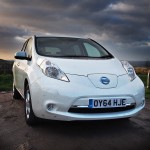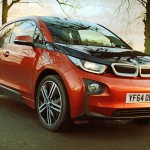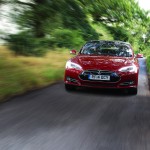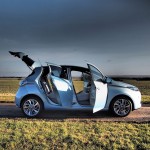Drivers have only one weekend left to get a £5,000 discount on an ultra-green car. From 1st March 2016 the maximum subsidy available to purchasers of the greenest cars will be cut from £5,000 to £4,500 as ministers reduce taxpayer support for each vehicle sold. As part of the overhaul of the plug-in car grant scheme, vehicles will also be divided into three sub categories depending on the extent of their green credentials. For certain vehicles this will result in a maximum pay out of no more than £2,500. A few will be excluded altogether. However, the slow-moving plug-in van grant scheme is not set to change.
These are the new categories and the maximum grant available from 1st March 2016:
- Category 1 – CO₂ emissions of less than 50g/km and a zero emission range of at least 70 miles. £4,500 grant.
- Category 2 – CO₂ emissions of less than 50g/km and a zero emission range between 10 and 69 miles. £2,500 grant.
- Category 3 – CO₂ emissions of 50 to 75g/km and a zero emission range of at least 20 miles. £2,500 grant.
According to the Office for Low Emission Vehicles (OLEV) vehicles currently eligible for the plug-in car grant will fall into the following categories from 1st March 2016:
Category 1 Vehicles
- BMW i3
- BYD e6
- Citroen CZero
- Ford Focus Electric
- Kia Soul EV
- Mercedes-Benz B-Class Electric Drive
- Mitsubishi iMiEV
- Nissan e-NV200 5-seater and 7-seater
- Nissan LEAF
- Peugeot iON
- Renault Fluence
- Renault ZOE
- Smart fortwo electric drive
- Tesla Model S
- Toyota Mirai
- Volkswagen e-up!
- Volkswagen e-Golf
Category 2 Vehicles
- Audi A3 e-tron
- BMW i8 *
- BMW 225xe
- BMW 330e
- Mercedes-Benz C350 e
- Mitsubishi Outlander
- Toyota Prius Plug-in
- Vauxhall Ampera
- Volkswagen Golf GTE
- Volvo V60 D6 Twin Engine
- Volvo XC90 T8 Twin Engine *
Category 3 Vehicles
- Mercedes-Benz S500 Hybrid *
- Porsche Panamera S E-Hybrid *
* Any model or variant in categories 2 and 3 that from 1 March 2016 has a list price more than £60,000 will be excluded from the grant scheme. Based on current pricing this would affect some or all of the variants listed above, marked with an asterisk.
The Committee on Climate Change (CCC) estimates that for the UK to meet its legal obligations to cut greenhouse gases by 80% by 2050 – compared to 1990 levels – 9% of the new car market should be ultra-low carbon within the next five years. This means around 240,000 pure battery-powered cars being bought in 2020, more than 7.5 times the 31,000 vehicles sold in 2015 under the scheme.
The table below shows the number of plug-in car grant (currently worth up to £5,000 per vehicle) and plug-in van grant (worth up to £8,000) claims by quarter since launch.
| Quarter | Car Claims | Quarter | Van Claims |
|---|---|---|---|
| Jan – Mar 2011 | 462 | Jan – Mar 2011 | N/A |
| Apr – Jun 2011 | 230 | Apr – Jun 2011 | N/A |
| Jul – Sept 2011 | 104 | Jul – Sept 2011 | N/A |
| Oct – Dec 2011 | 109 | Oct – Dec 2011 | N/A |
| Jan – Mar 2012 | 400 | Jan – Mar 2012 | 0 |
| Apr – Jun 2012 | 406 | Apr – Jun 2012 | 99 |
| Jul – Sept 2012 | 599 | Jul – Sept 2012 | 41 |
| Oct – Dec 2012 | 710 | Oct – Dec 2012 | 75 |
| Jan – Mar 2013 | 612 | Jan – Mar 2013 | 49 |
| Apr – Jun 2013 | 920 | Apr – Jun 2013 | 46 |
| Jul – Sept 2013 | 1,109 | Jul – Sept 2013 | 53 |
| Oct – Dec 2013 | 1,047 | Oct – Dec 2013 | 41 |
| Jan – Mar 2014 | 2,015 | Jan – Mar 2014 | 37 |
| Apr – Jun 2014 | 2,536 | Apr – Jun 2014 | 196 |
| Jul – Sept 2014 | 4,889 | Jul – Sept 2014 | 170 |
| Oct – Dec 2014 | 5,976 | Oct – Dec 2014 | 206 |
| Jan – Mar 2015 | 8,558 | Jan – Mar 2015 | 298 |
| Apr – Jun 2015 | 6,992 | Apr – Jun 2015 | 251 |
| Jul – Sept 2015 | 6,957 | Jul – Sept 2015 | 163 |
| Oct – Dec 2015 | 8,453 | Oct – Dec 2015 | 181 |
| TOTAL | 53084 | TOTAL | 1906 |
Note: While the car grant started in January 2011 the van grant only started in February 2012
Steve Gooding, director of the RAC Foundation, said:
“Given that the market was almost non-existent just five years ago there has clearly been progress made in getting drivers to go ultra-low and manufacturers will be relieved government has decided to taper the grant rather than scrapping it completely. The question is whether the new grants will be enough to nudge our choice of vehicles towards the eco-friendliest options. One of the big success stories has been the Mitsubishi Outlander plug-in hybrid which currently attracts a £5,000 grant. But under the new rules that will fall to just £2,500. Much will depend on how manufacturers respond and whether they adapt their pricing policies. In many ways the big concern is the almost non-existent electric van market. This was perhaps where the greatest hope lay with expectations that urban delivery firms and local authorities, whose vehicles did known mileages and could be easily recharged at the depot overnight, would go electric. But for pure electric vehicles the barriers to mass-market take up have not yet fundamentally changed: range anxiety, the absence of a step change in battery technology, relatively high purchase prices and concerns over resale value.”
In documents released by the Committee on Climate Change before Christmas an unnamed car manufacturer is quoted as telling the committee that:
“The battery technology itself is still hugely expensive and without mass market take-up, predicted economies of scale will continue to go unrealised. Whilst legislation in the form of government targets gives OEMs [car manufacturers] direction, these should also be realistic. Many ULEVs today are sold at a loss in the expectation/hope that at some stage the market will take-off but in the current economic climate this cannot be maintained.”
The manufacturer goes on to warn that the price of electric cars might actually rise in the future, not fall as most anticipate and hope:
“If costs do not come down then it means OEMs will have to bear a greater burden should take-up increase and this could potentially mean prices will increase which would in turn lead to softening demand.”
Source; RAC Foundation







